weight HONDA CR-V 2007 RD1-RD5, RE7 / 3.G Owners Manual
[x] Cancel search | Manufacturer: HONDA, Model Year: 2007, Model line: CR-V, Model: HONDA CR-V 2007 RD1-RD5, RE7 / 3.GPages: 352, PDF Size: 5.77 MB
Page 22 of 352

Your seat belt system includes lap/
shoulder belts in all five seating
positions. The front seat belts are
also equipped with automatic seat
belt tensioners.
This system uses the same sensors
as the front airbags to monitor
whether the front seat belts are
latched or unlatch ed, and how much
weight is on the front passenger’s
seat (see pages and ). If the indicator comes on or the
beeper sounds when the driver’s seat
belt is latched and there is no f ront
seat passenger and no items on the
front seat, something may be
interf ering with the monitoring
system. Look f or and remove:
Any items under the f ront
passenger’s seat.
Any objects hanging on the seat or
in the seat-back pocket.
Any objects, such as a f olded-down
back seat, that are touching the
rear of the seat-back.
If no obstructions are f ound, have
your vehicle checked by a dealer.
This system monitors the f ront seat
belts. If you turn the ignition switch
to the ON (II) position bef ore your
seat belt is f astened, the beeper will
sound and the indicator will f lash. If
your seat belt is not f astened bef ore the beeper stops, the indicator will
stop f lashing but remain on.
If a f ront passenger does not f asten
their seat belt, the indicator will
come on about 6 seconds af ter the
ignition switch is turned to the ON
(II) position.
If either the driver or a f ront
passenger does not f asten their seat
belt while driving, the beeper will
sound and the indicator will f lash
again at regular intervals.
When no one is sitting in the f ront
passenger’s seat, or a child or small
adult is riding there, the indicator
should not come on and the beeper
should not sound.
The seat belt system
includes an indicator on the
instrument panel and a beeper to
remind you and your passengers to
f asten your seat belts. 27 28
Seat Belt System Components
Additional Inf ormation About Your Seat Belts
18
Page 26 of 352

A irbag System Components
Additional Inf ormation About Your Airbags
22
(1)(2)
(3)
(4)(5)
(6) (5)
(4)
(12)
(8)
(11)(10)
(7)
(13)
(9)
(1) Driver’s Front Airbag
(2) Passenger’s Front Airbag
(3) Control Unit/Rollover Sensor
(4) Front Seat Belt Tensioners
(5) Side Airbags
(6) Driver’s Seat Position Sensor
(7) Front Passenger’s Weight Sensors
(8) Passenger Airbag Off Indicator
(9) Side Impact Sensors (First)
(10) Occupant Position Detection System (OPDS) Sensors
(11) Front Passenger’s Weight Sensor Unit/OPDS Sensors Control Unit
(12) SRS Indicator
(13) Seat Belt Buckle Tensioners
Page 28 of 352
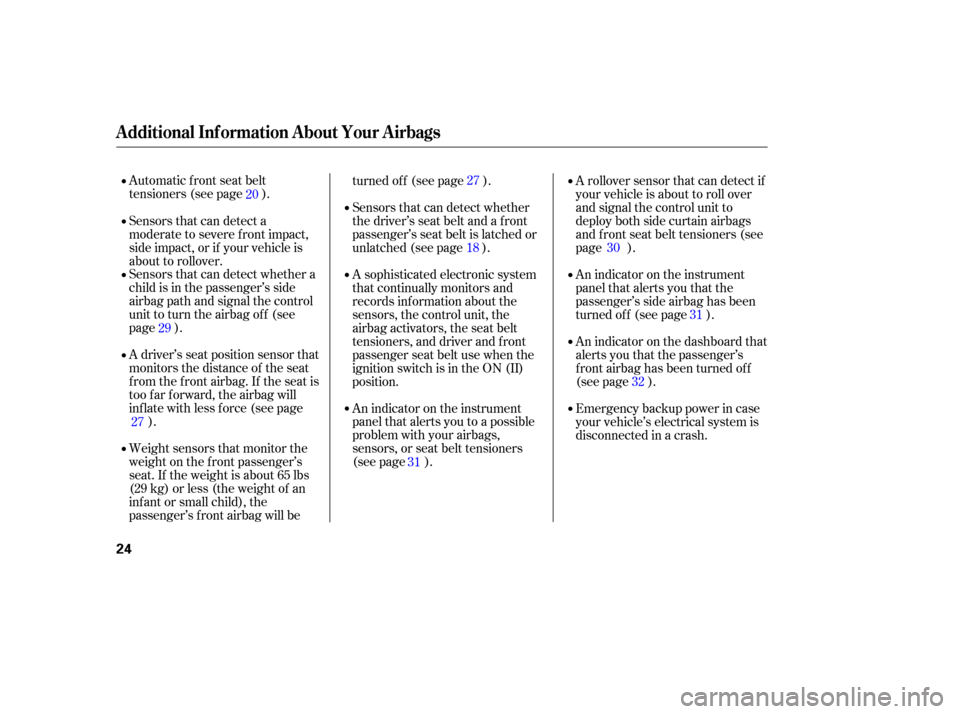
Automatic front seat belt
tensioners (see page ).
Sensors that can detect whether a
child is in the passenger’s side
airbag path and signal the control
unit to turn the airb ag off (see
page ).
A driver’s seat position sensor that
monitors the distance of the seat
from the front airbag. If the seat is
too far forward, the airbag will
inflate with less force (see page
).
Weight sensors that monitor the
weight on the front passenger’s
seat. If the weight is about 65 lbs
(29 kg) or less (the weight of an
infant or sm all child), the
passenger’s front airbag will be turned
off (see page ).
Sensors that can detect whether
the driver’s seat belt and a front
passenger’s seat belt is latched or
unlatch ed (see page ).
A sophisticated electronic system
that continually monitors and
reco rds information about the
sensors, the control unit, the
airbag activators, the seat belt
tensioners, and driver and front
passenger seat belt use when the
ignition switch is in the ON (II)
position.
An indicator on the instrument
panel that alerts you to a possible
problem with your airbags,
sensors, or seat belt tensioners
(see page ). A
rollover sensor that can detect if
your vehicle is about to roll over
and signal the control unit to
deploy both side curtain airbags
and front seat belt tensioners (see
page ).
An indicator on the instrument
panel that alerts you that the
passenger’s side airbag has been
turned off (see page ).
An indicator on the dashboard that
alerts you that the passenger’s
front airbag has been turned off
(see page ).
Emergency backup power in case
your vehicle’s electrical system is
disconnected in a crash.
Sensors that can detect a
moderate to severe front impact,
side impact, or if your vehicle is
about to rollover.
27
20
29
27 18
31 31
32
30
Additional Inf ormation About Your Airbags
24
Page 31 of 352
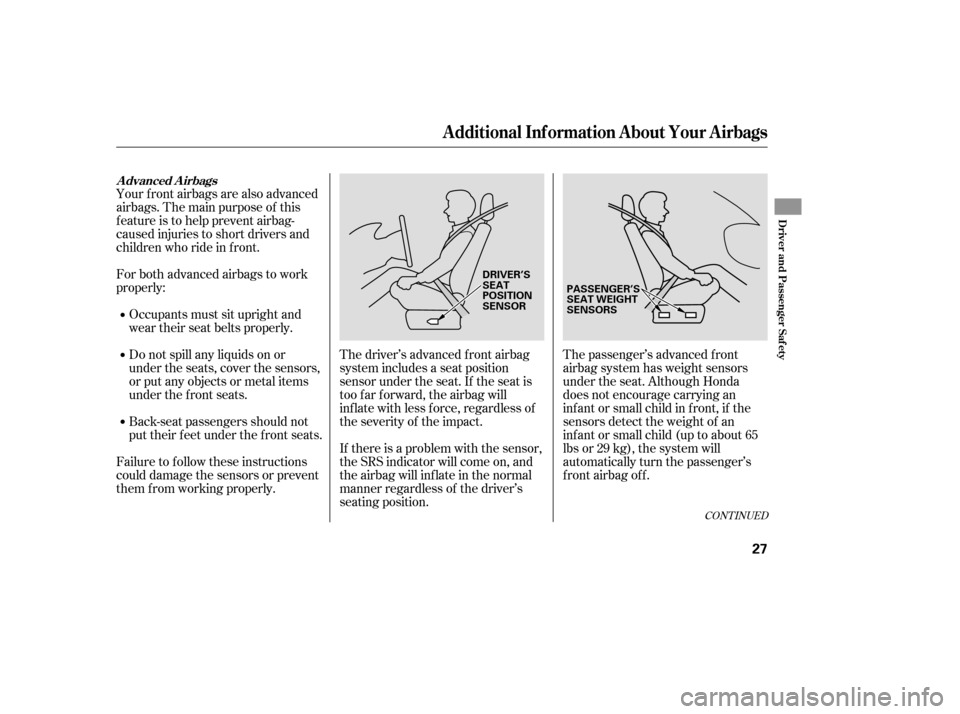
Your f ront airbags are also advanced
airbags. The main purpose of this
feature is to help prevent airbag-
caused injuries to short drivers and
children who ride in f ront.
For both advanced airbags to work
properly:Occupants must sit upright and
wear their seat belts properly.
Back-seat passengers should not
put their f eet under the f ront seats.
Failure to f ollow these instructions
could damage the sensors or prevent
them f rom working properly. The driver’s advanced front airbag
system includes a seat position
sensor under the seat. If the seat is
too f ar f orward, the airbag will
inf late with less f orce, regardless of
the severity of the impact.
If there is a problem with the sensor,
the SRS indicator will come on, and
the airbag will inf late in the normal
manner regardless of the driver’s
seating position.The passenger’s advanced f ront
airbag system has weight sensors
under the seat. Although Honda
does not encourage carrying an
inf ant or small child in f ront, if the
sensors detect the weight of an
inf ant or small child (up to about 65
lbs or 29 kg), the system will
automatically turn the passenger’s
front airbag off.
Do not spill any liquids on or
under the seats, cover the sensors,
or put any objects or metal items
under the f ront seats.
CONT INUED
Advanced Airbags
Additional Inf ormation About Your Airbags
Driver and Passenger Saf ety
27
DRIVER’S
SEAT
POSITION
SENSOR
PASSENGER’S
SEAT WEIGHT
SENSORS
Page 32 of 352
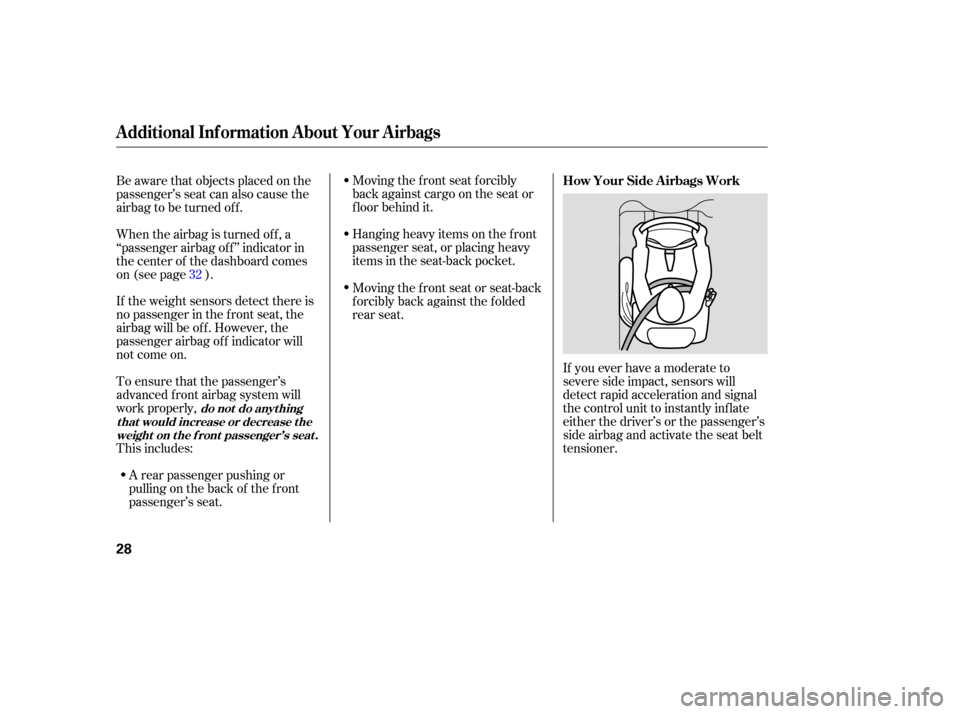
Moving the front seat forcibly
back against cargo on the seat or
floor behind it.
Hanging heavy items on the front
passenger seat, or placing heavy
items in the seat-back pocket.
If you ever have a moderate to
severe side impact, sensors will
de tect rapid accele ration and signal
the control unit to instantly inflate
either the driver’s or the passenger’s
side airbag and activate the seat belt
tensioner.
To
ensure that the passenger’s
advanced front airbag system will
work properly,
This includes:
If
the weight sensors detect there is
no passenger in the front seat, the
airbag will be off. However, the
passenger airbag off indicator will
not come on.
Wh
en the airbag is turned off, a
‘‘passenger airbag of f ’’ indicator in
the center of the dashboard comes
on (see page ). Be aware that objects placed on the
passenger’s seat can also cause the
airbag to be turned off.
A rear passenger pushing or
pulling on the back of the f ront
passenger’s seat. Moving the front seat or seat-back
f orcibly back against the f olded
rear seat.
32 How Your Side A irbags Work
do not do anyt hing
t hat would increase or decrease t he weight on the f ront passenger’s seat.
Additional Inf ormation About Your Airbags
28
Page 36 of 352
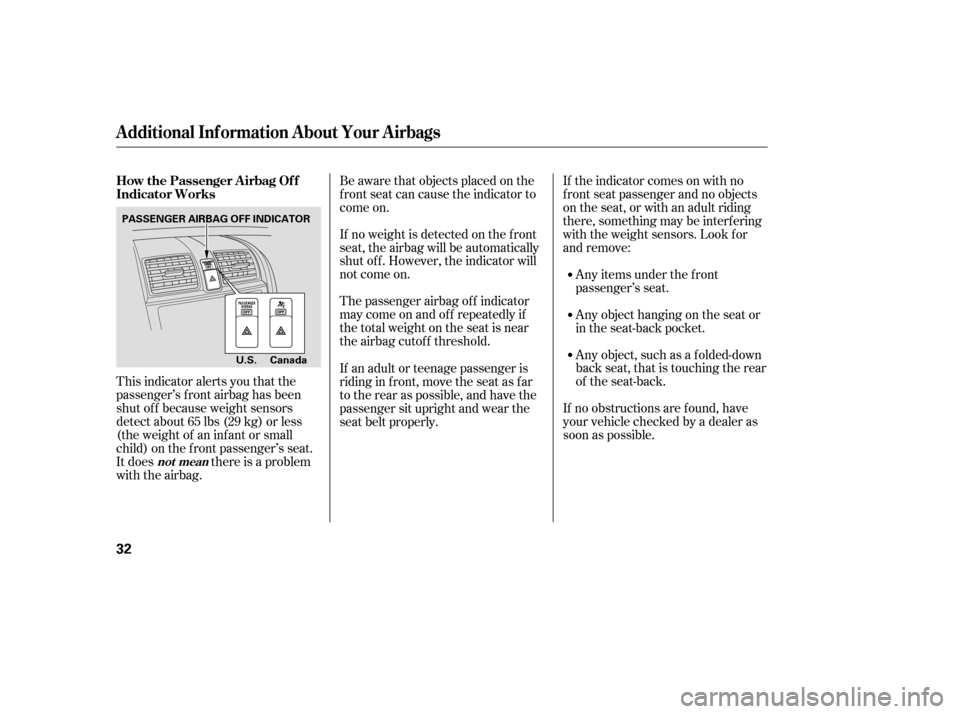
This indicator alerts you that the
passenger’s f ront airbag has been
shut of f because weight sensors
detect about 65 lbs (29 kg) or less
(the weight of an inf ant or small
child) on the f ront passenger’s seat.
It does there is a problem
with the airbag.Be aware that objects placed on the
f ront seat can cause the indicator to
come on.
If no weight is detected on the f ront
seat, the airbag will be automatically
shut of f . However, the indicator will
not come on.
The passenger airbag of f indicator
maycomeonandoff repeatedlyif
the total weight on the seat is near
the airbag cutof f threshold.
If the indicator comes on with no
f ront seat passenger and no objects
on the seat, or with an adult riding
there, something may be interf ering
with the weight sensors. Look f or
and remove:
Any items under the f ront
passenger’s seat.
Any object hanging on the seat or
in the seat-back pocket.
Any object, such as a f olded-down
back seat, that is touching the rear
of the seat-back.
If no obstructions are f ound, have
your vehicle checked by a dealer as
soon as possible.
If an adult or teenage passenger is
riding in f ront, move the seat as f ar
to the rear as possible, and have the
passenger sit upright and wear the
seat belt properly.
How the Passenger Airbag Of f
Indicator Works
not mean
Additional Inf ormation About Your Airbags
32
PASSENGER AIRBAG OFF INDICATOR
Canada
U.S.
Page 37 of 352

If water or
another liquid soaks into a seat-
back, it can prevent the side airbag
cutof f system f rom working
properly.
Improperly replacing
or covering f ront seat-back covers
can prevent your side airbags f rom
inf lating during a side impact.
This could make the
driver’s seat position sensor or the
f ront passenger’s weight sensors
inef f ective. If it is necessary to
remove or modif y a f ront seat to
accommodate a person with
disabilities, f irst contact Honda
Automobile Customer Service at
(800) 999-1009.
Tampering could cause
the airbags to deploy, possibly
causing very serious injury. Together, airbags and
seat belts provide the best
protection. Even if your
airbags do not inflate, your dealer
should inspect the driver’s seat
position sensor, the f ront
passenger’s weight sensors, the
f ront seat belt tensioners, and all
seat belts worn during the crash to
make sure they are operating
properly.
Your airbag systems are virtually
maintenance f ree, and there are no
parts you can saf ely service.
However, you must have your
vehicle serviced if:
Any airbag
that has deployed must be
replaced along with the control
unit and other related parts. Any
seat belt tensioner that activates
must also be replaced.
Do not try to remove or replace
anyairbagbyyourself.Thismust
be done by an authorized dealer or
a knowledgeable body shop.
Take your vehicle to an
authorized dealer as soon as
possible. If you ignore this
indication, your airbags may not
operate properly.
Do not expose the f ront passenger’s
seat-back to liquid.
Do not cover or replace f ront seat -back covers wit hout consult ingyour dealer.
Do not remove or modif y a f rontseat without consulting yourdealer.
Do not t amper wit h airbag component s or wiring f or anyreason.
Donotattempttodeactivateyour
airbags.
If your vehicle has a moderat e t o
severe impact .
An airbag ever inf lates.
T he SRS indicat or alert s you t o aproblem.
Additional Saf ety Precautions
Airbag Service
Additional Inf ormation About Your Airbags
Driver and Passenger Saf ety
33
Page 43 of 352
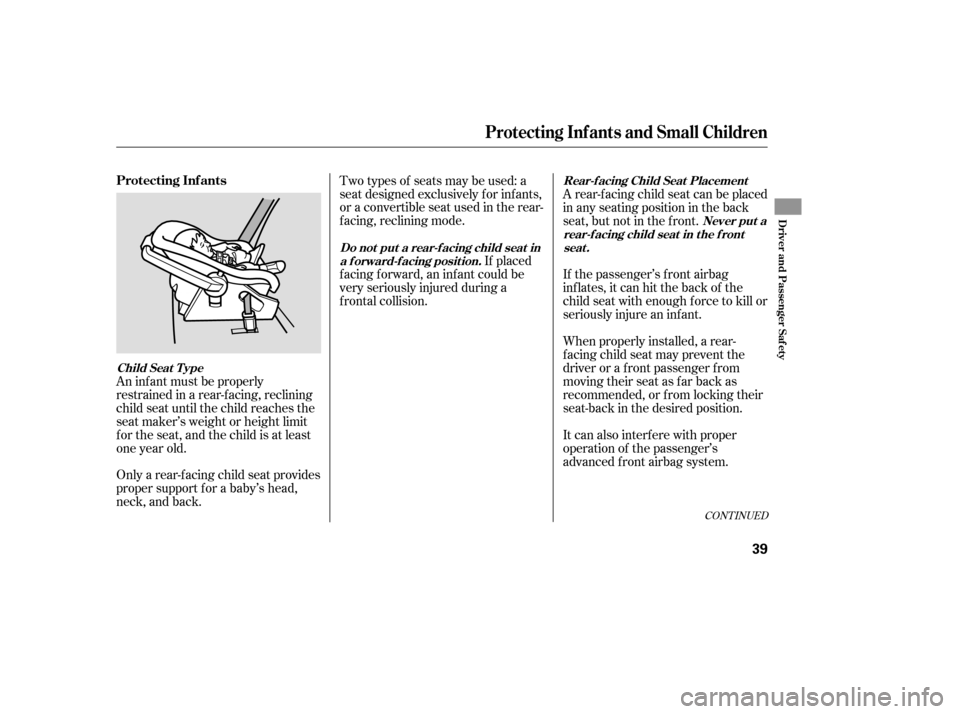
Only a rear-f acing child seat provides
proper support f or a baby’s head,
neck, and back. An inf ant must be properly
restrained in a rear-f acing, reclining
child seat until the child reaches the
seat maker’s weight or height limit
f or the seat, and the child is at least
one year old.Two types of seats may be used: a
seat designed exclusively f or inf ants,
or a convertible seat used in the rear-
f acing, reclining mode.
If placed
f acing f orward, an inf ant could be
very seriously injured during a
f rontal collision. A rear-f acing child seat can be placed
in any seating position in the back
seat, but not in the f ront.
If the passenger’s front airbag
inflates, it can hit the back of the
child seat with enough f orce to kill or
seriously injure an inf ant.
When properly installed, a rear-
f acing child seat may prevent the
driver or a f ront passenger f rom
moving their seat as far back as
recommended, or f rom locking their
seat-back in the desired position.
It can also interf ere with proper
operation of the passenger’s
advanced front airbag system.
CONT INUED
Do not put a rear-f acing child seat in
a f orward-f acing position.
Child Seat T ype Rear-f acing Child Seat Placement
Never put a
rear-f acing child seat in t he f ront seat .
Protecting Inf ants
Protecting Inf ants and Small Children
Driver and Passenger Saf ety
39
Page 44 of 352
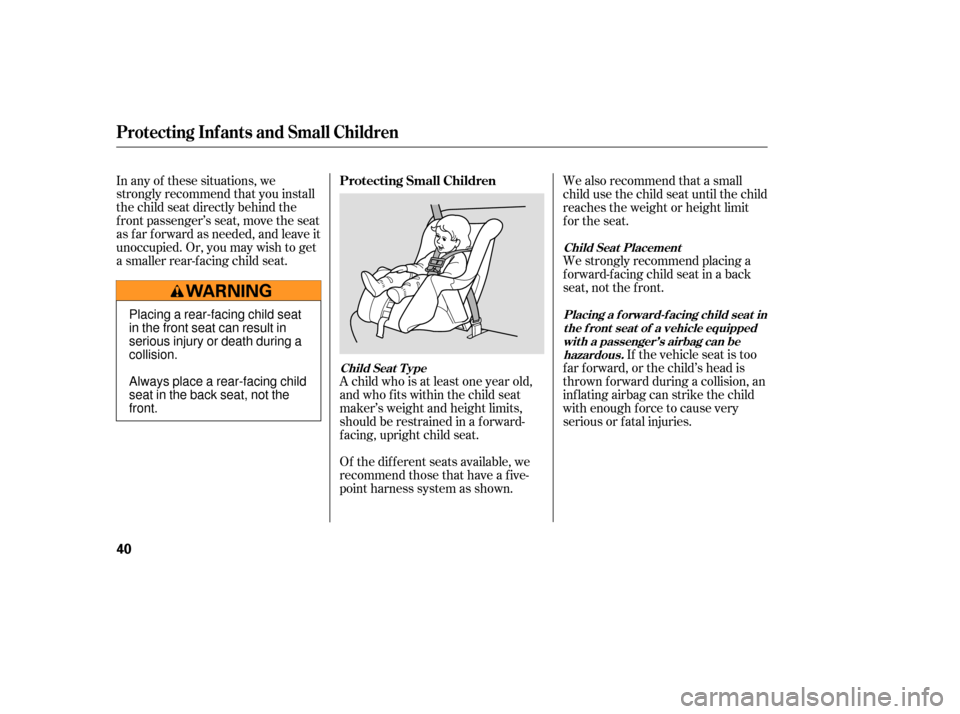
Of the different seats available, we
recommend those that have a f ive-
point harness system as shown.
In any of these situations, we
strongly recommend that you install
the child seat directly behind the
f ront passenger’s seat, move the seat
as far forward as needed, and leave it
unoccupied. Or, you may wish to get
a smaller rear-f acing child seat.
We also recommend that a small
child use the child seat until the child
reaches the weight or height limit
for the seat.
We strongly recommend placing a
forward-facing child seat in a back
seat, not the f ront.
If the vehicle seat is too
f ar f orward, or the child’s head is
thrown f orward during a collision, an
inf lating airbag can strike the child
with enough force to cause very
serious or fatal injuries.
A child who is at least one year old,
and who fits within the child seat
maker’s weight and height limits,
should be restrained in a f orward-
f acing, upright child seat. Protecting Small Children
Child Seat T ype Child Seat Placement
Placing a f orward-f acing child seat inthe f ront seat of a vehicle equippedwith a passenger’s airbag can behazardous.
Protecting Inf ants and Small Children
40
Placing a rear-facing child seat
in the front seat can result in
serious injury or death during a
collision.
Always place a rear-facing child
seat in the back seat, not the
front.
Page 51 of 352

Af ter conf irming that the belt is
locked, grab the shoulder part of
the belt near the buckle, and pull
up to remove any slack from the
lap part of the belt. Remember, if
the lap part of the belt is not tight,
the child seat will not be secure.Push and pull the child seat
f orward and f rom side-to-side to
verify that it is secure enough to
stay upright during normal driving
maneuvers. If the child seat is not
secure, unlatch the belt, allow it to
retract f ully, then repeat these
steps.To deactivate the lockable retractor
and remove a child seat, unlatch the
buckle, unroute the seat belt, and let
the belt fully retract.
To remove slack, it may help to
putweightonthechildseat,or
push on the back of the seat while
pulling up on the belt.
4. 5.
Installing a Child Seat
Driver and Passenger Saf ety
47